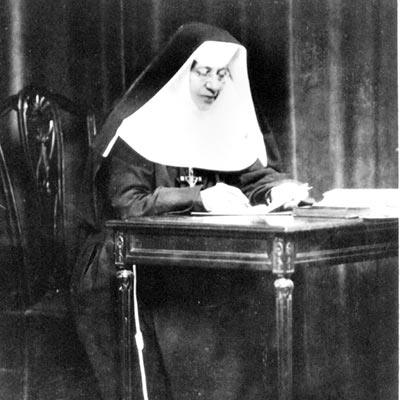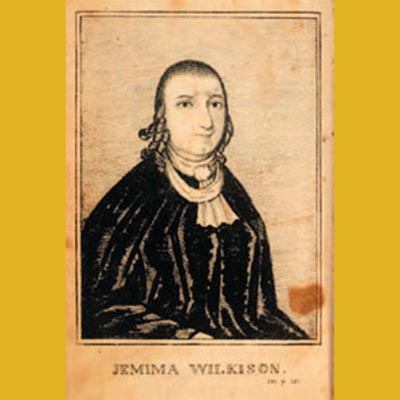They Believed What? Eight Philly Religious Fanatics
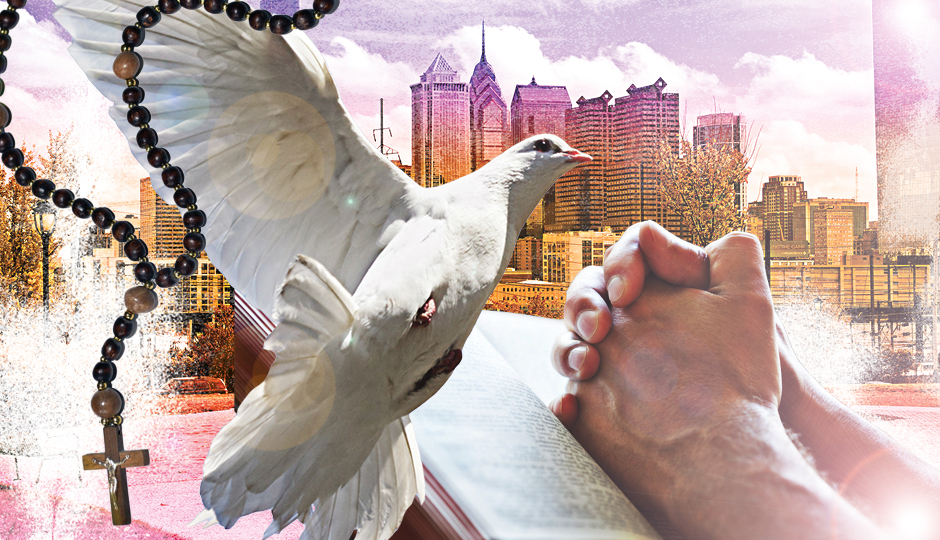
Photo illustration by Alyse Moyer. Source images via Shutterstock and Jeff Fusco for Visit Philadelphia
For all the mountains of fuss being made over Pope Francis’s impending visit, you’d think we’d never seen a holy man hereabouts. Not true! Pennsylvania was founded as a haven for heretics, so it shouldn’t be surprising that its major city has been home to some curious religious figures in its 333 (oooh, that’s half of 666!) years of history. Here are eight of the most intriguing local believers — and what they’ve believed.
Michael Marcarvage
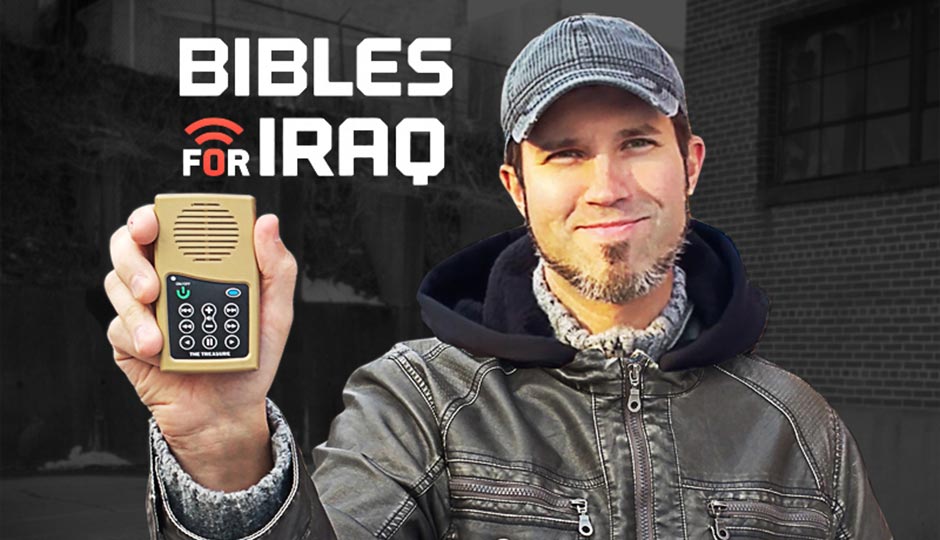
Marcavage via biblesforiraq.org
Marcavage, a 2001 Temple honors grad, is the founder of Repent America, a national ministry founded here. A stout defender of biblical marriage and opponent of abortion, he regularly organizes appearances of followers at major events like the Super Bowl. (If you’re interested, the application to join in is here.)
In 2004, he and 10 disciples were arrested and charged under the state’s hate-crimes bill during a protest at the Outfest gay festival. All the charges were eventually dismissed, and the bill was ruled unconstitutional. He’s also been convicted for preaching and protesting abortion at Independence Mall, but the conviction was overturned in federal court in 2009.
In the wake of a federal judge’s decision not to require the Dover, Delaware, school district to teach that the theory of evolution is “not a fact,” Marcavage and his followers proselytized to the contrary at thousands of homes in the area. He’s currently trying to raise money online to give Bibles to Iraqi refugees and serves as editor of the Christian News Network.
Anthony Marcolongo
Originally a follower of itinerant Bethlehem-born evangelist and strict fundamentalist (some say cult leader) Ralph “Brother” Stair, Marcolongo established his own small congregation, the Church of Our First Love, in Drexel Hill in the 1980s. Believers spent as much as four hours a day in prayer and pooled their financial resources. After Marcolongo was accused by former congregation members and their families of stealing money and subjecting them to physical and sexual abuse, his congregation dwindled, and he moved with what remained to a farm in Clearfield County to await the end of the world. He died in a car accident in 1992 at age 38. Stair, charged in 2002 of second degree criminal sexual conduct, pleaded guilty to assault and battery and continues to preach today.
Frederick A. Drummond
In the 1970s, Drummond founded the Church of Our Savior in Concordville, Delaware County; disgruntled followers claimed he spanked them as discipline and used their money to buy himself luxuries, including a pink Rolls-Royce. One family accused him of causing the death of their daughter by denying her medication for her epilepsy; a young man charged him with leading him into a homosexual relationship; a wealthy follower charged him with taking his life savings to refurbish a yacht.
Authorities investigated, but as then-district attorney Frank Hazel told the Inquirer, “This guy has some kind of hold over people. Do I think it’s normal or nice? No.” But, he added, people “have a constitutional right to be stupid, and an extraordinary number of people have chosen to exercise that right.”
Despite Drummond’s checkered past, the University of Pennsylvania leased him a Gothic stone church at 42nd and Spruce in West Philly in 1989. He held services there for several years before the university asked him to vacate after student members accused him of “mind control.” In 2013, a former senior member of the Church of Our Savior, Richard Bellingham, pleaded guilty to sexually assaulting children in the congregation in the 1980s and was sentenced to state prison. The church is now defunct; Drummond has started a new one in Florida.
St. Katharine Drexel
St. Katharine Drexel was born into a tony, philanthropic family in 1858—an uncle founded Drexel University; her dad was investment banker Francis Anthony Drexel. Katharine’s mother died weeks after her birth; she and her sister were cared for by relatives until Francis married his second wife, Emma Bouvier, a daughter of the great-great-grandfather of Jackie O. Katharine led a typical debutante life, though her parents also emphasized good works; she was educated by private tutors and toured the United States and Europe.
Katharine became interested in the welfare of Native Americans; when, on a tour of Europe following their father’s death in 1885, she and her sisters were received by Pope Leo XIII and requested that he send missionaries to the Western states to serve them, he suggested that Katharine become a missionary herself. Forgoing several marriage proposals, the young heiress did so, entering the Sisters of Mercy convent.
Known as “Mother Katharine,” she ministered to and opened boarding schools for Indian tribes in 16 states. She also devoted herself to civil rights for black Americans, founding Xavier University in New Orleans, the only historically black Roman Catholic college in the U.S. Over 60 years, she spent some $20 million of her personal fortune on her good works. She died in 1955 at age 96, was beatified in 1988, and was canonized in 2000 after the Vatican determined that she had cured a deaf child. She’s buried at the St. Katharine Drexel Mission Center and National Shrine in Bensalem.
Stewart Traill
The son of a Canadian Presbyterian minister, Traill was selling vacuum cleaners in the 1960s in Allentown when he married, found salvation, joined a Pentecostal church that eventually expelled him, and formed a group called the “Forever Family.” That group morphed into the Church of Bible Understanding, or COBU, with satellite missions throughout the Northeast. While he amassed a fortune, he demanded total obedience, reportedly weighing his wife in public and berating and spanking her if he didn’t like the results. In the early ’70s, he began open-air preaching and converting at the Robin Hood Dell; eventually he led some 130 “fellowship houses” and attracted as many as 3,000 people to his “Big Meetings.”
After a New York City-based training center failed, Traill, supported by follower-funded camera and carpet-cleaning businesses (the latter the basis for the carpet-cleaning cult in Seinfeld), founded the Philadelphia Lamb House to train initiates. He was accused by a youth pastor of recruiting homeless young people out of shelters; a judge would issue an injunction barring his followers from “housing or transporting anyone under age 18 without parental permission.” In the 1980s, four COBU members in Philadelphia were convicted of beating Traill’s youngest son at Traill’s behest, first with a belt, then with a board, sending him to CHOP in serious condition. “We didn’t want to hit him with the board,” one defendant testified, “but the belt had no effect. We stopped when the board broke.” Sabrina Rubin Erdely infiltrated the COBU cult and wrote an award-winning feature about it for Philly Mag in 1999. The Internet is filled with the (angry) firsthand stories of former members. Today, Traill, 79, reportedly lives in a mansion in Florida. Though COBU membership peaked in 1978, the group still runs a troubled orphanage in Haiti as well as Olde Good Things, an architectural-salvage business.
Jemima Wilkinson
In 1776, the 24-year-old daughter of two Rhode Island Quakers developed a fever and went into a coma; when she emerged, she informed those around her that the person they had known as Jemima was dead and a new spirit, neither male nor female, now inhabited her body — one they should address only as the Public Universal Friend.
Wilkinson, who had joined the New Light Baptists before becoming ill, began to speak out publicly — a great rarity for a woman in that era — calling for a return to morality and emphasizing the dangers of sin and the need for repentance. (One contemporary noted, “She do preach up terror alarmingly.”) She dressed in men’s clothing, including a black robe and a white cravat, and traveled atop a white horse. A total eclipse of the sun in 1780 added to her following as well as her conviction that the end of the world was nigh.
Her Society of Universal Friends, the first religion founded by an American-born woman, prized celibacy and held property in common; she was at first received warmly by Quakers she visited in Philadelphia, but they turned on her when some of her followers described her as “Jesus in female form” and claimed her as the Messiah. She moved to Worcester, Montgomery County, to a house given her by a wealthy local farmer, and her fame and following grew as she preached over the next eight years. Her sexually ambiguous disciples attracted much attention in the press and in 1790 began to flee the “wicked world,” traveling up the Susquehanna River to establish a new home in upstate New York that they called Jerusalem; her house there still stands. She and the Universal Friends faced a number of lawsuits over property in her later years; without her commanding presence and leadership, the Friends disbanded following her death in 1819.
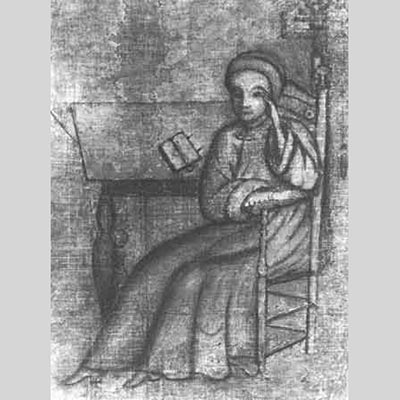
“Johannes Kelpius” by Christopher Witt – The Historical Society of Pennsylvania, public domain.
Johannes Kelpius
In 1694, at the invitation of William Penn, this German mystic and scholar led a band of 40 followers to Philadelphia, where they settled along the shores of the Wissahickon Creek, meditated, lived in celibacy, studied astronomy, played and composed music, provided healing services and education to the locals, and awaited the imminent end of the world. The group called itself the Society of the Woman in the Wilderness, based on a figure in the Book of Revelations; locally, they became known as the Monks of the Ridge or the Monks of the Wissahickon.
Legend said that Kelpius possessed the fabled philosopher’s stone that could convert base metal into gold, and that he ordered it thrown into the Wissahickon shortly before his death from tuberculosis in 1708, at age 41. The remnants of his movement scattered, with some merging into the larger community and others joining Ephrata Cloister. Today, Kelpius is honored by a historical marker outside the cave that was supposedly his home (directions here).
Father Divine

African American spiritual leader Father Divine smiles as he leads a parade of his followers from Harlem to the docks in New York, on Aug. 20, 1936, to board the paddle-steamer City of Kennsburg to take them on the first stage of their great trek to their new camp in Ulster County, New York State.
Unlike the other religious leaders on this list, Father Divine — or, as he named himself, the Reverend Major Jealous Divine — didn’t stop at worshiping God; he actually claimed he was God.
Born around 1876, perhaps in Maryland, he became a follower of a traveling preacher named Samuel Morris, who also claimed to be God; Father Divine, then known as The Messenger, was his right-hand man. This tidy arrangement fell apart when a third follower, who called himself the Reverend Bishop St. John the Vine, disputed Morris’s claim that he alone was God. Father Divine struck out on his own, preaching throughout the South, attracting largely black female followers while advocating celibacy and the erasure of gender and race classifications.
Some of the husbands of his flock had him arrested for lunacy, which only furthered his notoriety. (He was tried as “John Doe, alias God.”) He and his disciples formed a commune in Brooklyn, and he married a much younger woman named Penninah, who then became “Mother Divine.” Both said their marriage was never consummated.
With their followers, they moved to Sayville, New York, and began to attract whites as well as blacks via Father Divine’s preaching, free banquets and job fairs. Neighbors angered by the continual ruckus on the property — not to mention its integrated nature — accused Father Divine of possessing a harem and harming their property values. A raid by the police, heavily covered by the New York press, resulted in much larger crowds at his speaking engagements.
Father Divine was found guilty of disturbing the peace by a judge who died only days later; “I hated to do it,” Father Divine reportedly said of the death. He preached for years in Harlem, and after a series of adventures, more arrests, an FBI investigation, lawsuits, and splits within his Universal Peace Mission Movement, he moved to Philadelphia in 1942, establishing his headquarters here. Penninah soon died despite followers’ belief that she, like Father Divine, was immortal. In 1946 her widower married a 21-year-old Canadian woman, Edna Rose Ritchings, though this marriage, too, he said, was never consummated. (He claimed Ritchings was the reincarnation of Penninah.)
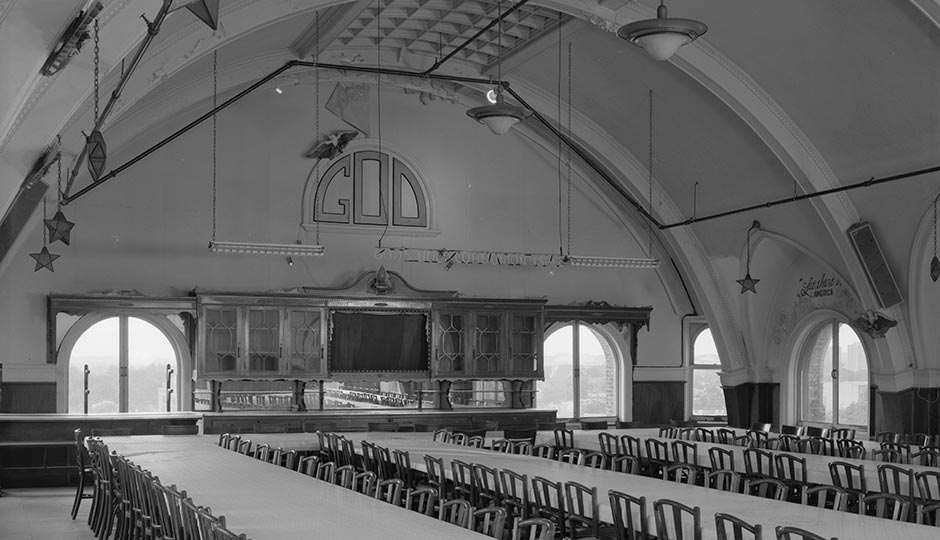
“Divine Lorraine” by Joseph Elliott, HABS photographer, public domain.
After he bought the Lorraine Hotel on North Board Street, he renamed it the Divine Lorraine Hotel and turned it into the first fully integrated hotel in the United States. He lived more quietly here than he had in New York but continued his efforts for social justice. In the wake of World War II, his following eroded somewhat; he lived out his days on an estate in Gladwyne, known as Woodmont, that had been given to him by a believer. After Father’s death in 1965, Ritchings took on his sect’s leadership role, resisting an effort by the notorious Jim Jones (of Jonestown, Guyana) to convince her that he was her dead husband’s reincarnation. In fact, Ritchings and her followers — she still lives at Woodmont — have never acknowledged Father Divine’s death. Since the movement forbids sex, few members remain.
Follow @SandyHingston on Twitter.
